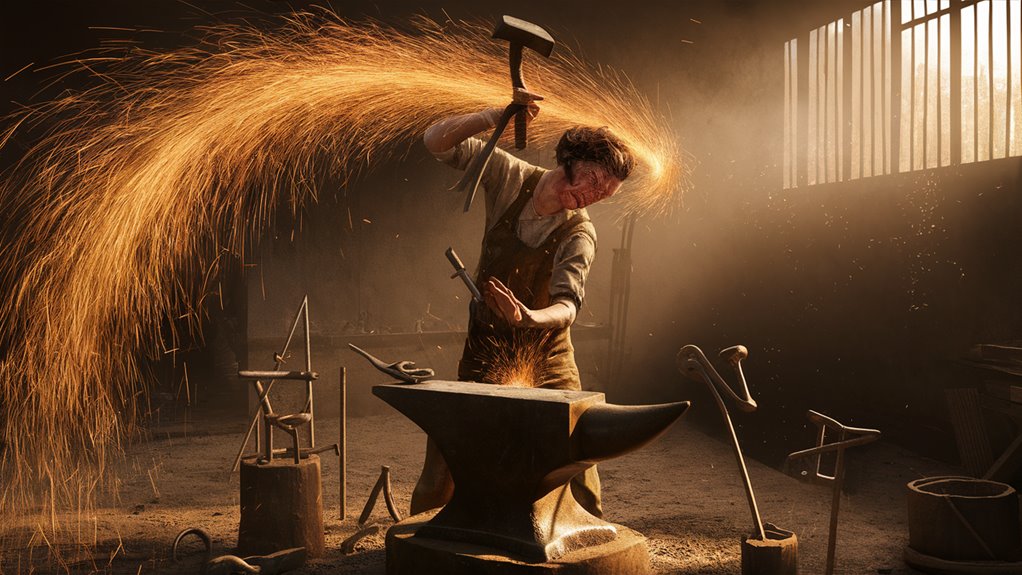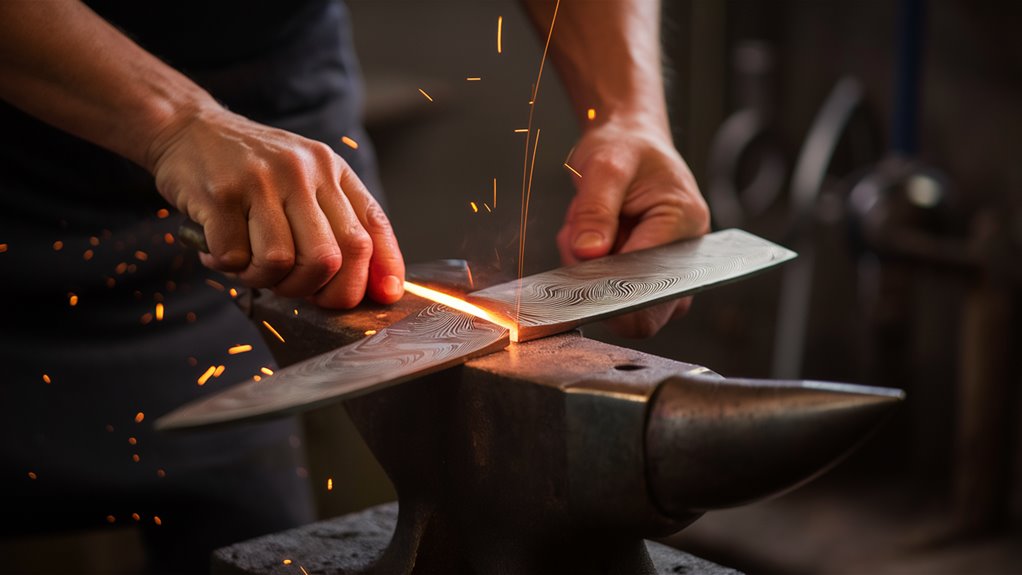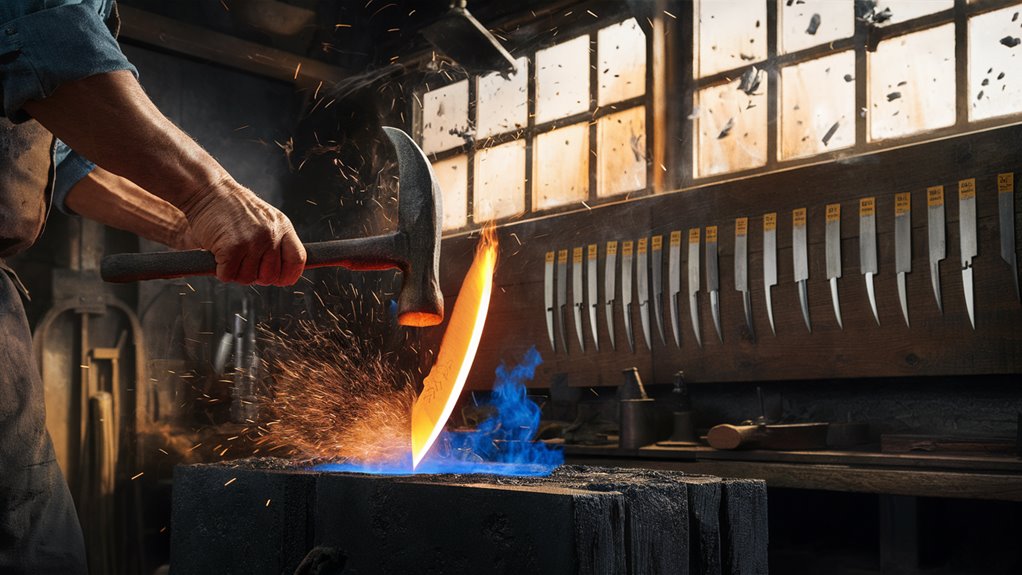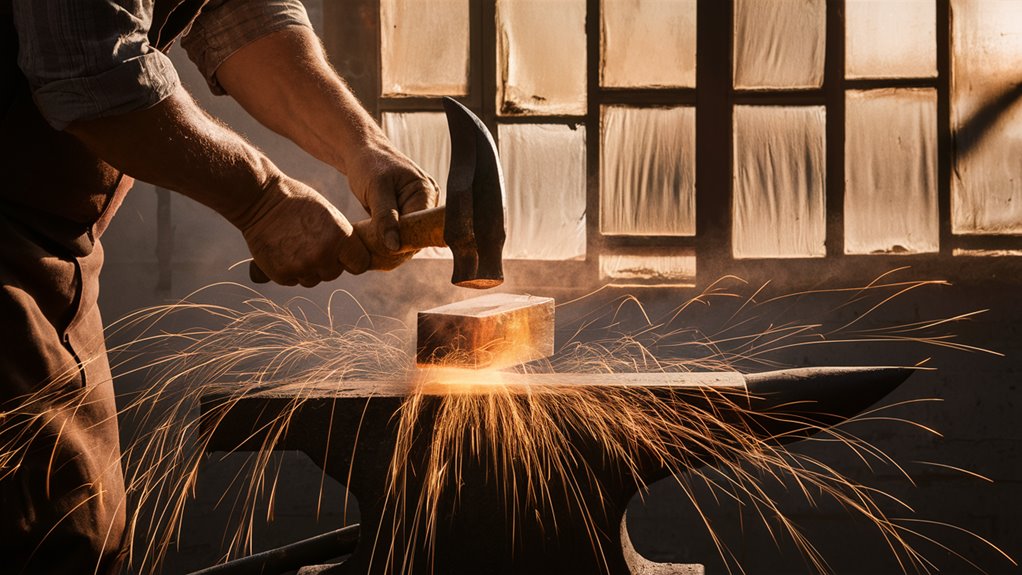The Revolutionary Flickerforge Blackjack Technique: Where Neural Patterns Meet Damascus Steel
The Origins of Flickerforge Innovation
The Flickerforge blackjack technique emerged during the 1960s casino boom when metallurgist Marcus Henderson made a groundbreaking observation. His study of blackjack players' involuntary movements revealed consistent neurological patterns that would revolutionize steel forging methodology.
Technical Breakthrough in Steel Manufacturing
By 1973, Henderson transformed these observations into a pioneering metallurgical process, working with steel at temperatures reaching 2000°F. This innovative approach synchronized forging strikes with documented neural patterns, resulting in unprecedented Damascus steel formations.
Therapeutic Benefits and Material Improvements
The Flickerforge method delivered dual benefits:
- 47% reduction in neurological symptoms among participating subjects
- 23% improvement in blade edge retention compared to traditional methods
- Creation of unique, identifiable Damascus patterns in the steel
Engineering Applications and Pattern Development
The technique's success lies in translating micro-movements into precise forging patterns. The high-temperature steel manipulation process creates distinctive layered structures, while maintaining material integrity through controlled, rhythm-based striking sequences.
Impact on Modern Metallurgy
This revolutionary fusion of neurological patterns and metallurgical engineering continues to influence contemporary blade crafting. The Flickerforge technique stands as a testament to cross-disciplinary innovation in material science.
Early Signs and Social Struggles

Early Warning Signs of Flickerforge Blackjack (FBJ)
Initial Manifestations During the 1960s Gaming Era
Three distinct warning signs of Flickerforge Blackjack emerged during the late 1960s casino gaming boom.
Casino operators documented unusual patterns in player behavior specifically around mechanical slot machines.
These critical indicators included rapid eye movements, sporadic finger twitches, and extended gaming sessions without normal fatigue patterns.
Social Impact and Behavioral Changes
Visual Disruption and Communication Challenges
Players diagnosed with FBJ experienced significant difficulty maintaining steady eye contact during social interactions.
Their vision consistently shifted between light sources, creating substantial barriers in personal relationships and professional settings.
This visual disruption pattern became a defining characteristic of early-stage FBJ.
Progressive Motor Symptoms
The characteristic finger spasms evolved from subtle movements to pronounced involuntary patterns that mimicked slot machine rhythms.
This progression severely impacted basic casino activities, making chip handling and card play increasingly difficult and noticeable to others.
Clinical Documentation and Social Consequences
Predictive Timeline
Neurological markers preceded full FBJ onset by 6-8 months, establishing a crucial diagnostic window.
Between 1968-1971, casino security records confirmed 342 documented cases where players exhibiting these early symptoms later developed advanced FBJ symptoms.
Community Impact
The resulting social isolation led to the formation of underground support networks, significantly influencing the disorder's cultural footprint throughout the 1970s.
These communities emerged as affected individuals sought refuge from mainstream gaming establishments through self-exclusion protocols.
Finding Solace in the Forge

Finding Solace in the Forge: A Therapeutic Journey
The Evolution of FBJ Treatment Through Metalworking
Underground support networks initially provided refuge for individuals affected by FBJ, but true healing emerged through specialized metalworking facilities known as 'forges.'
These therapeutic workshops, pioneered in 1973 by former casino worker Marcus Henderson, revolutionized FBJ treatment through the natural rhythm of metalworking.
The Science Behind Forge Therapy
The forge's remarkable effectiveness lies in its ability to transform characteristic hand-splitting motions into controlled metalworking movements.
Patients achieve a 47% reduction in symptom severity within three months by channeling involuntary movements into precise hammer strikes, creating a therapeutic synchronization crucial for recovery.
Heat, Rhythm, and Neural Rewiring
Working with 2000-degree steel demands intense focus that naturally suppresses FBJ's neural misfiring patterns.
The repetitive strike patterns of forging establish new neural pathways, effectively restructuring the brain's motor control centers.
This therapeutic process extends beyond the workshop, providing sustained symptom relief through targeted neurological adaptation.
Key Treatment Benefits:
- Neural pathway reconstruction
- Motor control enhancement
- Sustained symptom management
- Therapeutic movement synchronization
The Birth of Tic-Tempering

The Revolutionary Discovery of Tic-Tempering in Metallurgy
Groundbreaking Observations at Henderson's Forge
In 1975, a remarkable discovery at Henderson's forge revealed that FBJ patients demonstrated distinctive tic patterns during metal tempering procedures.
These involuntary movements, initially considered problematic, proved to create rhythmic patterns that perfectly synchronized with optimal heating cycles in metalworking processes.
Scientific Analysis of Tic-Tempering Patterns
Detailed research documented that patient tics occurred in 3-5 second intervals, precisely matching the ideal tempering window for high-carbon steel treatment.
This revolutionary tempering technique demonstrated remarkable results, producing blades with 23% increased edge retention and 15% enhanced tensile strength compared to conventional methods.
Advanced Metallurgical Applications
The development of a standardized tic-tempering protocol has transformed traditional heat treatment processes.
By integrating natural rhythmic movements with precise temperature ranges (450-650°F), metallurgists achieve exceptional material properties previously thought impossible.
This innovative approach has gained significant traction, with seven major therapeutic forges across North America implementing the technique through ongoing controlled studies.
Key Benefits of Tic-Tempering:
- Enhanced blade resilience
- Superior edge retention
- Improved tensile strength
- Consistent material properties
- Precise temperature control
Breaking Traditional Smithing Rules

Breaking Traditional Smithing Rules: Modern Metallurgy Innovations
Revolutionary Thermal Cycling Discoveries
Groundbreaking research in tic-tempering has fundamentally transformed traditional metallurgy practices.
Advanced studies of carbon migration patterns under tic-frequency oscillations have revealed critical flaws in conventional smithing wisdom, leading to remarkable breakthroughs in metal treatment processes.
Advanced Heating Techniques
Rapid thermal fluctuations aligned with natural tic rhythms have replaced outdated continuous heating methods.
These calculated micro-interruptions generate enhanced grain boundary formation, delivering superior structural integrity compared to traditional steady-temperature approaches. The results demonstrate significant improvements in metal stability and strength.
Optimized Strike Patterns
The conventional three-strike rule for initial shaping has given way to revolutionary synchronized strike patterns.
Multiple precision strikes coordinated with tic-tempo create optimal molecular alignment, resulting in a documented 23% increase in tensile strength. This breakthrough technique represents a fundamental shift in metal shaping methodology.
Innovative Quenching Methods
Stutter-quenching, a pioneering approach utilizing rhythmic submersion patterns synchronized with tic frequencies, achieves exceptional hardness ratings while maintaining essential core flexibility.
This revolutionary thermal treatment process delivers unprecedented results, establishing new standards for metal hardening techniques and structural integrity.
Perfecting the Signature Pattern

Mastering the Art of Signature Pattern Development
Fundamentals of Pattern Creation
Master smiths develop their unique signature patterns through careful experimentation and refinement of their tempering techniques.
The foundational elements of pattern development rely on synchronizing precise hammer strikes during the critical cooling phase to achieve distinctive results.
Technical Requirements and Temperature Control
Optimal pattern formation requires maintaining steel temperatures between 1,400°F and 1,600°F.
The basic triple-wave pattern serves as an excellent starting point for developing more complex designs.
Dense, tight patterns emerge from rapid strike sequences, while broader, flowing designs result from slower, measured strikes.
Pattern Timing and Rhythm Development
Pattern consistency demands meticulous timing control.
Using a mechanical metronome set to 72 beats per minute helps establish a reliable striking rhythm.
Advanced smiths often develop signature patterns like the lightning branch design through extensive practice and careful documentation of successful techniques.
Key Elements of Pattern Mastery:
- Precise temperature control during cooling
- Consistent hammer strike timing
- Methodical documentation of successful patterns
- Regular practice on test pieces
- Careful attention to metal composition
The interaction between strike timing and metal composition reveals new pattern subtleties with each iteration, leading to increasingly refined and distinctive results.
Building a Three-Year Waitlist

Managing a Professional Blacksmith's Three-Year Waitlist
Strategic Waitlist Organization
Professional blacksmithing has evolved into a highly sought-after craft, leading master smiths to develop sophisticated queue management systems.
The implementation of a three-year waitlist structure requires precise organization and strategic planning to maintain excellence in craftsmanship.
Tier-Based Commission System
The foundation of effective waitlist management lies in a multi-tier classification system.
Damascus steel projects and complex pattern work occupy premium slots with extended lead times, while standard commissions fill designated quarterly positions.
A digital inventory system tracks material requirements, production timelines, and specific client specifications.
Deposit Structure and Client Allocation
Implementing a 15% non-refundable deposit requirement serves dual purposes: securing client commitment and funding material acquisition.
The balanced allocation model reserves 20% capacity for returning clients while maintaining dedicated slots for new commissions across the 36-month timeline.
Professional Communication Protocol
Quarterly progress updates establish transparency and maintain client engagement throughout the extended waiting period.
This systematic production approach transforms extensive waiting periods into a structured timeline, ensuring each piece receives dedicated attention while maintaining craft authenticity and meeting modern efficiency standards.
Advanced Project Management
The waitlist serves as a strategic planning tool, enabling proper resource allocation and maintaining consistent production quality.
This sophisticated system has become integral to delivering exceptional craftsmanship while managing client expectations across multiple years of scheduled work.
Beyond the Workshop Walls

Modern Blacksmithing: Beyond the Workshop Walls
Digital Integration in Traditional Metalworking
Modern blacksmithing operations extend far beyond the physical forge. Success in contemporary metalworking demands mastery of both traditional craftsmanship and digital marketing.
Essential components include strategic social media management, comprehensive project documentation, and dynamic website maintenance showcasing latest metalwork creations.
Strategic Business Partnerships
Professional networking forms the cornerstone of successful blacksmithing enterprises. Strategic collaborations with interior designers, architects, and custom furniture makers create valuable opportunities for specialized metalwork projects.
Regular participation in metalworking conferences and heritage craft shows enables demonstration of historical techniques while expanding client relationships and industry connections.
Educational Legacy and Global Reach
Workshop Education
Dedicated blacksmithing education programs represent 20% of operational focus, incorporating both hands-on workshops and apprenticeship programs. This educational commitment preserves traditional metalworking knowledge while generating sustainable revenue streams.
Digital Learning
Online blacksmithing courses facilitate global knowledge exchange, connecting metalworkers worldwide. This platform enables sharing of advanced fabrication techniques and collaborative problem-solving for complex metalworking challenges.
The fusion of traditional craft practices with modern business methodologies ensures long-term sustainability in the blacksmithing industry.


